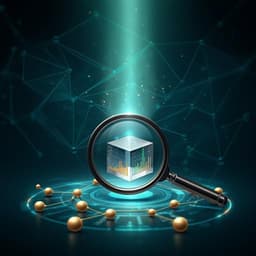
Space Sciences
Influx of nitrogen-rich material from the outer Solar System indicated by iron nitride in Ryugu samples
T. Matsumoto, T. Noguchi, et al.
Discover how our latest research reveals the presence of iron nitride on asteroid Ryugu, indicating a fascinating process of inorganic nitrogen fixation. Conducted by a diverse team of authors, this study opens exciting possibilities regarding nitrogen availability for planetary formation from the outer Solar System.
~3 min • Beginner • English
Introduction
Nitrogen distribution in primitive materials tracks chemical evolution in the early Solar System. Remote sensing suggests outer Solar System bodies (comets, icy bodies) host substantial solid nitrogen (for example, ammonium salts), but a compositional link to interplanetary dust particles and Antarctic micrometeorites delivered to near-Earth space remains elusive. Lunar ilmenite isotope studies indicate exogenous nitrogen from asteroidal micrometeoroids, yet their nitrogen abundances are unconstrained. JAXA’s Hayabusa2 returned chemically primitive Ryugu samples consistent with CI chondrites. These grains record space weathering by micrometeoroid impacts and solar wind. Metallic iron is a common space-weathering product on lunar and S-type asteroid regoliths, but Ryugu’s oxidizing, hydrated environment complicates metallic iron formation and interaction with exogenous components. This study targets the major Fe-bearing minerals in Ryugu (iron sulfides, magnetite, and carbonate) to identify space-weathering-induced changes in Fe redox and mineralogy and to assess evidence for nitrogen fixation at airless surfaces.
Literature Review
Prior work indicates: (1) outer Solar System bodies contain nitrogen-rich solids, including ammonium salts (for example, on comets and Ceres); (2) delivered IDPs and Antarctic micrometeorites have not shown such salts, obscuring source-sink links; (3) exogenous nitrogen on the Moon derives from asteroidal micrometeoroids, but the nitrogen flux is poorly quantified; (4) space weathering produces metallic iron from silicates and sulfides (observed on Moon and Itokawa), including growth of Fe whiskers via sulfur loss from pyrrhotite; (5) Ryugu samples preserve space-weathered phyllosilicates with Fe3+ reduced to Fe2+. However, nitrogen-bearing minerals formed by space weathering have not been directly observed. Roaldite (Fe4N) occurs in iron meteorites and some chondrites via nebular processes, but nitride formation at airless regolith surfaces is unreported. This gap motivates investigating whether space weathering on Ryugu can fix nitrogen as iron nitride and what this implies about nitrogen transport to the inner Solar System.
Methodology
Samples: Ryugu grains from Hayabusa2 first and second touchdown sites (chambers A and C). Fine grains (~100 μm) and coarse fragments were curated under N2 in gloveboxes. Grains were mounted on plates (gold, aluminium, indium) with epoxy as appropriate.
Analytical imaging and spectroscopy: Over 800 fine grains were surveyed by FE-SEM and FIB-SEM at Kyoto, Kyushu, and JAXA to locate space-weathered regions. SEM operated at low kV (2–3 kV) and low beam currents to minimize damage; elemental mapping via SEM-EDX at 15 kV, ~100 pA.
FIB-TEM/STEM: Electron-transparent lamellae were extracted with protective e-beam and Ga+ Pt coats; sections thinned to 50–200 nm. TEM (JEOL JEM-2100F) and STEM-EDX used BF/DF imaging, SAED, 4D-STEM nanobeam diffraction and Z-factor quantification for elemental abundances (line profiles with ~3–5 nm resolution). Position-averaged nanobeam diffraction (NBD) patterns assessed crystallography.
EELS: Monochromated aberration-corrected STEM (JEM-ARM200F, 200 kV) measured Fe L2,3 edges and O K-edge with 0.2–0.3 eV resolution (0.25 eV/channel). Fourier-ratio deconvolution removed plural scattering. Vesicle vs amorphous silicate O K-edge was compared to identify molecular oxygen signatures.
Irradiation experiment: Selected magnetite grains were irradiated with 4 keV He+ to a total dose of 1.3×10^18 ions cm−2 (flux ~1.5×10^13 ions cm−2 s−1) to simulate solar wind. Post-irradiation Fe/O depth profiles were measured.
Flux and exposure calculations: Nitrogen inventory in a 50-nm Fe4N layer on 1 cm2 was estimated assuming one N per Fe4N unit cell (volume 5.4×10−2 nm3), yielding 9.2×10^16 N atoms cm−2. Solar wind N flux at 1 AU (N/H = 6.81×10−5; H flux 2.80×10^5 cm−2 s−1) gave FN = 6.02×10^11 cm−2 yr−1; exposure duration DN at 1.19 AU was computed as DN = (9.2×10^16 / FN) × 1.19^2. Surface residence time was constrained from solar flare track densities in coexisting olivine (5–7×10^3 yr).
Thermochemical modeling: Fe–N–O and Fe–S–O potential diagrams constructed using thermochemical data (NIST-JANAF; Göhring et al. for Fe4N) and equilibrated CI-vapour compositions from impact modeling (Kuwahara & Sugita; Schaefer & Fegley). Nitriding potential P(NH3)/P(H2)^(3/2) and redox conditions were compared to Fe4N stability (450–950 K).
Key Findings
- Space-weathered magnetite surfaces are coated by granular, iron-rich layers with increasing Fe/O toward the surface and enrichment in Si and Mg; in two grains, the iron-rich layers also contain sulfur (up to ~5 at.%) and nitrogen (up to ~9 at.%).
- Electron diffraction and EELS show reduced iron states in the iron-rich layer; bcc Fe is present and cubic iron nitride (Fe4N; roaldite-like) is identified. In one grain, the nitride lattice constant is ~2% larger than typical roaldite (0.379 nm). Superlattice reflections from ordered N are absent, likely due to electron-beam damage.
- A third magnetite grain hosts bcc Fe without N or S enrichment.
- Iron sulfides exhibit abundant <100-nm pores and iron whiskers comprising bcc and fcc Fe with up to ~51 at.% Ni (taenite-like). Modified sulfides include 4C pyrrhotite (Fe7S8), non-integral (NC) pyrrhotite (FeS), troilite (FeS), and pentlandite; troilite dominates modified areas. Near-surface diffraction shows only the NiAs-type 1C subcell, indicating loss of long-range superstructure.
- Iron-bearing minerals (sulfides and Fe metal) are mantled by 30–40 nm Si–Mg–rich layers, interpreted as vapour deposits from sputtering/impacts.
- Carbonate (breunnerite) surfaces are transformed to a ferropericlase-rich rim with Mg/(Mg+Fe+Mn) ~0.75; substrate shows crystallographic damage to 110–130 nm depth, and surface is depleted in C and O with detectable Si and S.
- Phyllosilicates adjacent to modified Fe-bearing minerals display smooth/frothy textures and ~100-nm amorphous rims; microcraters and melt deposits are present. O K-edge EELS from crater vesicles shows a sharp pre-edge at 531 eV, consistent with molecular O-bearing species.
- He+ irradiation of Ryugu magnetite increases near-surface Fe/O and produces damaged surface regions, supporting solar wind contribution to oxygen loss.
- A 50-nm Fe4N layer contains 9.2×10^16 N atoms cm−2. Based on solar flare track residence times (5–7×10^3 yr), the inferred N supply rate to magnetite is 4–6×10^5 atoms cm−2 s−1, which is 20–300× higher than exogenous N supply estimated for lunar ilmenite (0.2–2×10^4 atoms cm−2 s−1).
- If sourced solely from solar wind N (FN = 6.02×10^11 cm−2 yr−1 at 1 AU), forming 50 nm Fe4N at Ryugu’s 1.19 AU would require ~2.2×10^5 yr, far longer than observed surface exposure ages (≤3,500 yr), implying solar wind N is not the dominant source.
- Thermochemical analysis of CI impact vapour shows N2 and NH3 are dominant N species, but at relevant conditions CI vapour would stabilize magnetite over Fe nitride unless more reducing or more NH3-rich; N2 is poorly dissociated for nitridation. Local enhancement of NH3 and/or reducing conditions is required.
- Co-occurrence of N and S in iron-rich surface layers suggests nitridation by NHx-bearing, S-rich micro-impactors. The data imply impacts of nitrogen-rich dust (e.g., ammonium salts or N-rich IOM from comets/outer Solar System) onto Ryugu’s regolith.
Discussion
The coexistence of modified magnetite, iron sulfides, carbonates, and phyllosilicates with melt deposits and microcraters shows classic space-weathering signatures from micrometeoroid bombardment and solar wind irradiation. Oxygen and sulfur volatilization from Fe-bearing minerals yields metallic Fe even on Ryugu’s oxidized surface; reduced Fe on magnetite likely forms by preferential oxygen loss and possibly reaction with implanted H. Iron whiskers on sulfides reflect sulfur loss and Fe diffusion to limited nucleation sites, whereas numerous Fe nanoparticles on magnetite reflect limited Fe diffusion.
The discovery of Fe4N on magnetite demonstrates nitrogen fixation via nitridation of pre-formed metallic Fe at the regolith surface—the first mineralogical evidence of such a process on an airless body. The absence of universal N enrichment across all grains indicates that nitridation postdated Fe formation and occurred episodically. Quantitative constraints indicate that solar wind N alone cannot account for the observed nitride thickness within measured exposure ages. Sputtering/implantation of N from Ryugu’s organic matter is also unlikely to dominate, given expected co-formation of Fe carbides that are not observed.
Impact-generated vapours from CI-like projectiles contain NH3 and N2, but standard CI vapour compositions are too oxidizing to stabilize Fe4N. Local conditions could become more reducing via accumulated solar wind H or dehydration of phyllosilicates. More plausibly, NH3-rich, nitrogen-dense exogenous dust (e.g., ammonium salts from comets and outer-belt bodies or N-rich IOM in cometary/ultracarbonaceous IDPs) could transiently create ammonia-rich vapours upon high-velocity micro-impacts, enabling Fe nitridation. The frequent association of N with S supports a dust source containing both N- and S-bearing phases.
These findings imply a higher-than-expected influx of nitrogen-rich solids to the near-Earth region and, by extension, greater nitrogen availability during terrestrial planet formation and for prebiotic chemistry than inferred from bulk compositions of most IDPs and Antarctic micrometeorites.
Conclusion
Ryugu grains preserve iron nitride (Fe4N) on space-weathered magnetite surfaces, formed by nitridation of metallic iron produced through selective volatile (O, S) loss under solar wind and micrometeoroid bombardment. Quantitative flux and exposure constraints exclude the solar wind as the primary nitrogen source and favor nitridation by NHx-bearing vapours from nitrogen-rich micro-impactors, likely derived from outer Solar System reservoirs (e.g., cometary ammonium salts or N-rich organic matter). This constitutes the first mineralogical evidence of nitrogen fixation associated with space weathering and suggests a substantial influx of nitrogen-rich solids into the inner Solar System, with implications for planetary volatile inventories and prebiotic chemistry. Future work, especially measurements of 14N/15N in the nitride and broader surveys of grains, will better constrain source reservoirs and processes.
Limitations
- Nitrogen-bearing layers were identified in two of three studied magnetite grains; nitridation may be episodic and not ubiquitous.
- No nitrogen isotopic measurements were reported; thus, the precise source reservoir (solar, cometary, asteroidal) remains unconstrained.
- Beam damage likely suppressed superlattice reflections of Fe4N, limiting detailed structural characterization of N ordering.
- Thermochemical modeling of impact vapour relies on equilibrium assumptions and specific impact conditions; actual micro-impact plumes may deviate from equilibrium and vary spatially and temporally.
- Endogenous Ryugu sources (e.g., ammoniated phyllosilicates or localized N-rich lithologies/ices) cannot be entirely excluded.
- Sample surfaces had some exposure to ambient lab gases during storage, although the authors argue against terrestrial N incorporation based on selective occurrence.
Related Publications
Explore these studies to deepen your understanding of the subject.







